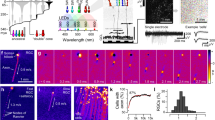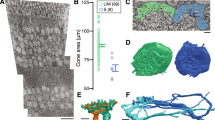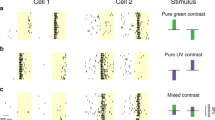Abstract
Color vision in humans and other Old World primates depends on differences in the absorption properties of three spectral types of cone photoreceptors. Primate cones are linked by gap junctions, but it is not known to what extent the various cone types are electrically coupled through these junctions. Here we show, by using a combination of dye labeling and electrical recordings in the retina of macaque monkeys, that neighboring red and green cones are homologously and heterologously coupled by nonrectifying gap junctions. This indiscriminate coupling blurs the differences between red- and green-cone signals. The average junctional conductance is about 650 pS. Our calculations indicate that coupling between red and green cones may cause a modest decrease in human color discrimination with a comparable increase in luminance discrimination.
This is a preview of subscription content, access via your institution
Access options
Subscribe to this journal
Receive 12 print issues and online access
$209.00 per year
only $17.42 per issue
Buy this article
- Purchase on Springer Link
- Instant access to full article PDF
Prices may be subject to local taxes which are calculated during checkout







Similar content being viewed by others
References
Baylor, D.A., Fuortes, M.G.F. & O'Bryan, P.M. Receptive fields of cones in the retina of turtle. J. Physiol. (Lond.) 214, 265–294 (1971).
DeVries, S.H., Qi, X., Smith, R., Makous, W. & Sterling, P. Electrical coupling between mammalian cones. Curr. Biol. 12, 1900–1907 (2002).
Lamb, T.D. & Simon, E.J. The relation between intercellular coupling and electrical noise in turtle photoreceptors. J. Physiol. (Lond.) 263, 257–286 (1976).
Tessier-Lavigne, M. & Attwell, D. The effect of photoreceptor coupling and synapse nonlinearity on signal:noise ratio in early visual processing. Proc. R. Soc. Lond. B 234, 171–197 (1988).
Bennett, M.V.L. & Zukin, R.S. Electrical coupling and neuronal synchronization in the mammalian brain. Neuron 41, 495–511 (2004).
Raviola, E. & Gilula, N.B. Gap junctions between photoreceptor cells in the vertebrate retina. Proc. Natl. Acad. Sci. USA 70, 1677–1681 (1973).
Tsukamoto, Y., Masarachia, P., Schein, S.J. & Sterling, P. Gap junctions between the pedicles of macaque foveal cones. Vision Res. 32, 1809–1815 (1992).
Kolb, H., Goede, P., Roberts, S., McDermott, R. & Gouras, P. Uniqueness of the S-cone pedicle in the human retina and consequences for color processing. J. Comp. Neurol. 386, 443–460 (1997).
Dartnall, H.J.A., Bowmaker, J.K. & Mollon, J.D. Human visual pigments: microspectrophotometric results from the eyes of seven persons. Proc. R. Soc. Lond. B 220, 115–130 (1983).
MacNichol, E.F., Levine, J.S., Mansfield, R.J.W., Lipetz, L.E. & Collins, B.A. Microspectrophotometry of visual pigments in primate photoreceptors. in Colour Vision (eds. Mollon, J.D. & Sharpe, L.T.) 13–38 (Academic, London, 1983).
Baylor, D.A., Nunn, B.J. & Schnapf, J.L. Spectral sensitivity of cones of the monkey Macaca fascicularis. J. Physiol. (Lond.) 390, 145–160 (1987).
Schnapf, J.L., Kraft, T.W. & Baylor, D.A. Spectral sensitivity of human cones. Nature 325, 439–441 (1987).
Davidson, J.S. & Baumgarten, I.M. Glycyrrhetinic acid derivatives: a novel class of inhibitors of gap-junctional intercellular communication. J. Pharmacol. Exp. Ther. 246, 1104–1107 (1988).
Weckstrom, M., Hardie, R.C. & Laughlin, S.B. Voltage-activated potassium channels in blowfly photoreceptors and their role in light adaptation. J. Physiol. (Lond.) 440, 635–657 (1991).
Yagi, T. & Macleish, P.R. Ionic conductances of monkey solitary cone inner segments. J. Neurophysiol. 71, 656–665 (1994).
Schnapf, J.L., Nunn, B.J., Meister, M. & Baylor, D.A. Visual transduction in cones of the monkey Macaca fascicularis. J. Physiol. (Lond.) 427, 681–713 (1990).
Schneeweis, D.M. & Schnapf, J.L. The photovoltage of macaque cone photoreceptors: adaptation, noise, and kinetics. J. Neurosci. 19, 1203–1216 (1999).
Slaughter, M.M. & Miller, R.F. 2-Amino-4-phosphonobutyric acid: a new pharmacological tool for retina research. Science 211, 182–185 (1981).
Verweij, J., Hornstein, E.P. & Schnapf, J.L. Surround antagonism in macaque cone photoreceptors. J. Neurosci. 23, 10249–10257 (2003).
Jahromi, S.S., Wentlandt, K., Piran, S. & Carlen, P.L. Anticonvulsant actions of gap junctional blockers in an in vitro seizure model. J. Neurophysiol. 88, 1893–1902 (2001).
Schneeweis, D.M. & Schnapf, J.L. Photovoltage of rods and cones in the macaque retina. Science 268, 1053–1056 (1995).
Hsu, A., Smith, R.G., Buchsbaum, G. & Sterling, P. Cost of cone coupling to trichromacy in primate fovea. J. Opt. Soc. Am. A 17, 635–640 (2000).
Roorda, A., Metha, A.B., Lennie, P. & Williams, D.R. Packing arrangement of the three cone classes in primate retina. Vision Res. 41, 1291–1306 (2001).
DeValois, R.L., Morgan, H.C., Polson, M.C., Mead, W.R. & Hull, E.M. Psychophysical studies of monkey vision. I. Macaque luminosity and color vision tests. Vision Res. 14, 53–67 (1974).
Wyszecki, G. & Stiles, W.S. Color Science: Concepts and Methods, Quantitative Data and Formulae (Wiley, New York, 1982).
Field, G.D. & Rieke, F. Nonlinear signal transfer from mouse rods to bipolar cells and implications for visual sensitivity. Neuron 34, 773–785 (2002).
Detwiler, P.B. & Hodgkin, A.L. Electrical coupling between cones in turtle retina. J. Physiol. (Lond.) 291s, 75–100 (1979).
Nathans, J., Thomas, D. & Hogness, D.S. Molecular genetics of human color vision: the genes encoding blue, green and red pigments. Science 232, 193–202 (1986).
Mollon, J.D. “Tho' she kneel'd in that place where they grew...”. The uses and origins of primate colour vision. J. Exp. Biol. 146, 21–38 (1989).
Mariani, A.P. The neural organization of the outer plexiform layer of the primate retina. Int. Rev. Cytol. 86, 285–320 (1983).
Bumsted, K., Jasoni, C., Szel, A. & Hendrickson, A. Spatial and temporal expression of cone opsins during monkey retinal development. J. Comp. Neurol. 378, 117–134 (1997).
Dacey, D.M., Diller, L.C., Verweij, J. & Williams, D.R. Physiology of L- and M-cone inputs to H1 horizontal cells in the primate retina. J. Opt. Soc. Am. A 17, 589–596 (2000).
Deeb, S.S., Diller, L., Williams, D.R. & Dacey, D.M. Interindividual and topographical variations of L:M cone ratios in monkey retinas. J. Opt. Soc. Am. A 17, 538–544 (2000).
Reid, R.C. & Shapley, R.M. Spatial structure of cone inputs to receptive fields in primate lateral geniculate nucleus. Nature 356, 716–718 (1992).
Martin, P.R., Lee, B.B., White, A.J.R., Solomon, S.G. & Ruttiger, L. Chromatic sensitivity of ganglion cells in the peripheral primate retina. Nature 410, 933–936 (2001).
Reid, R.C. & Shapley, R.M. Space and time maps of cone photoreceptor signals in macaque lateral geniculate nucleus. J. Neurosci. 22, 6158–6175 (2002).
Lennie, P., Haake, P.W. & Williams, D.R. The design of chromatically opponent receptive fields. in Computational Models of Visual Processing (eds. Landy, M.S. & Movshon, J.A.) 71–82 (MIT, Cambridge, 1991).
Calkins, D.J. & Sterling, P. Evidence that circuits for spatial and color vision segregate at the first retinal synapse. Neuron 24, 313–321 (1999).
Diller, L. et al. L and M cone contributions to the midget and parasol ganglion cell receptive fields of macaque monkey retina. J. Neurosci. 24, 1079–1088 (2004).
Li, W. & DeVries, S.H. Separate blue- and green-cone networks in the mammalian retina. Nat. Neurosci. 7, 751–756 (2004).
Lee, E-J. et al. The immunocytochemical localization of connexin 36 at rod and cone gap junctions in the guinea pig retina. Eur. J. Neurosci. 18, 2925–2934 (2003).
Srinivas, M. et al. Functional properties of channels formed by the neuronal gap junction protein connexin36. J. Neurosci. 19, 9848–9855 (1999).
Bendat, J.S. & Piersol, A.G. Random Data: Analysis and Measurement Procedures (Wiley, New York, 2000).
Nathans, J. The evolution and physiology of human color vision: insights from molecular genetic studies of visual pigments. Neuron 24, 299–312 (1999).
Acknowledgements
We thank D. Baylor, D. Copenhagen, P. Li, W. Makous, D. Schneeweis and M. Tessier-Lavigne for comments on the manuscript, D. Copenhagen for valuable assistance with confocal microscopy and S. Massey for discussions on dye labeling. This work was supported by grants EY07642, EY07001 and EY07120 from the NIH and a grant from That Man May See, Inc. Additional support was received from Research to Prevent Blindness.
Author information
Authors and Affiliations
Corresponding authors
Ethics declarations
Competing interests
The authors declare no competing financial interests.
Rights and permissions
About this article
Cite this article
Hornstein, E., Verweij, J. & Schnapf, J. Electrical coupling between red and green cones in primate retina. Nat Neurosci 7, 745–750 (2004). https://doi.org/10.1038/nn1274
Received:
Accepted:
Published:
Issue Date:
DOI: https://doi.org/10.1038/nn1274
This article is cited by
-
Interphotoreceptor coupling: an evolutionary perspective
Pflügers Archiv - European Journal of Physiology (2021)
-
Characterization of connexin36 gap junctions in the human outer retina
Brain Structure and Function (2016)
-
Expression and Localization of Connexins in the Outer Retina of the Mouse
Journal of Molecular Neuroscience (2016)
-
Expression of connexin genes in the human retina
BMC Ophthalmology (2010)
-
The diverse functional roles and regulation of neuronal gap junctions in the retina
Nature Reviews Neuroscience (2009)



